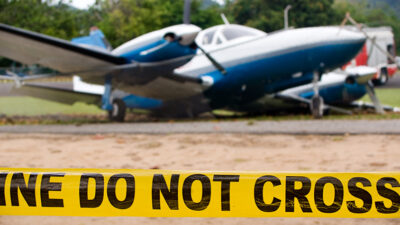sUAS Crisis Management: Ensuring Successful Communications During Crisis Response Operations

In 2017, the United States endured many natural disasters, terrorist attacks, and other forms of destruction. Throughout these national crises and incidents, the small Unmanned Aircraft Systems (sUAS) industry launched more flights than ever to aid in the relief efforts. When a crisis hits, professionals tasked with responding rely on information that can be delivered quickly and from as many sources as possible. However, it is not uncommon for communication to be complicated and even become compromised during a crisis.
Best Practices for Efficient sUAS Crew Communications
During Crisis Response Operations
Action Plan/Crisis Response Plan
A written plan provides confidence and stability during a stressful event. The plan should cover any possible incident and be designed so anyone can work through the plan, complete the mission, and effectively communicate to the appropriate chain of command. This plan should include specific instructions from beginning to end for each proposed mission. For example:
- Phase 1: Initial Response
The priority for the Pilot in Command (PIC) is to perform a rapid area assessment for life safety and possible property salvage efforts. This phase allows for identification of hazard zones that can be used by the incident commander when sending out ground-based units for initial response. It also allows for proper communication to better plan for the next phase. - Phase 2: Secondary Response
This should be a more thorough data collection mission based upon what was collected and communicated in phase one. The PIC will typically return to certain areas to determine the extent of damage or hazard and next steps.
Clear Understanding of Mission
As an sUAS pilot, it is imperative to have a clear understanding of what data and intelligence is required before launching a drone. It is the responsibility of the PIC to conduct a pre-flight briefing with all members of the crew to review the planned flight, individual roles and responsibilities, and the communication plan.
Training and Practice
sUAS pilots who may conduct any incident-response mission must be able to think fast and adapt to any situation in a matter of seconds. Since anything is possible, simulation training is absolutely vital with the implementation of sUAS. Simulating real-mission stress during training allows participants to practice all components of their job. Fast decision making under real-mission stress is achieved while still learning without negative repercussions.
Real-World sUAS Crisis: Hurricane Matthew
DARTdrones’ Chief Public Safety Flight Instructor Mike Uleski launched his department’s sUAS to aid in Hurricane Matthew disaster relief. When reviewing the main factors of communication for this specific mission, it is clear that without proper plans and training, communication and safety may collapse.
In October 2016, Mike’s agency held an operational briefing regarding all plans for before, during, and after the hurricane. At the meeting, Mike was tasked with flying the department’s sUAS unit for post-storm search and rescue, damage assessment, and structural inspections. As you can see, Mike had a clear understanding of his purpose for this specific mission.
Abiding by all FAA rules and Temporary Flight Restrictions (TFR), Mike contacted the air traffic control (ATC) for Daytona Beach International Airport, Class C airspace. He received airspace authorization and was required to contact ATC both prior to takeoff and once UAS operations were completed. Mike launched a DJI Phantom 3 Advanced sUAS and performed two phases. Phase one consisted of search and rescue/damage assessment and was completed in two hours. Any areas of potential life safety risks were assessed. Any areas of damage were noted for closer inspection after completing the initial assessment. This information was communicated to available ground resources, including the city building department for determination of unsafe structures. The purpose of phase two was to collect more thorough data.
All data was quickly captured, downloaded, and communicated to the city public works department before beginning hazard clearing. The local power company used the information for analysis of the integrity of the power grid, and the building department used it for building inspections. The area’s finance department also used the data for documentation for FEMA reimbursements. With this detailed sUAS data, the city was able to quickly and efficiently evaluate damage and correctly prioritize clean up.
The Bottom Line
Overall, drones can provide critical intelligence for national crises and incidents. However, no matter how advanced the technology, proper preparation, coordination, and communication is still the deciding factor for ensuring a successful sUAS mission outcome during high-stress flight operations associated with emergency response. Having a plan and training for any circumstance is essential to ensuring safety and efficiency.

DARTdrones, the nation’s leading drone training company and new Global Aerospace SM4 partner, offers courses in 40+ cities across the U.S. DARTdrones offers basic flight training classes, Part 107 Airman Knowledge test prep courses, advanced industry specific training, and UAS program implementation consulting services. DARTdrones has been helping individuals and organizations develop safe and efficient sUAS programs and continues to keep new and developing safety considerations at the forefront of their curriculum development. For more information, visit us or call the team at 800-264-3907. DARTdrones was featured on ABC’s Shark Tank in February 2017.
http://www.dartdrones.com
© 2024 DARTdrones. All Rights Reserved.
Next ArticleRelated Posts

Fatal Accidents and Personal Effects: Why Expert Handling Is Essential
The devastating consequences of fatal aviation accidents cannot be overstated. An organization relies on its Emergency Response Plan (ERP) to navigate such a tragedy.

Aviation Emergency Response and the Media
With recent advancements in technology, the media has become more accessible to everyone, and social media platforms have greatly increased the speed with which information can be shared. As a communication method, the media can be an excellent tool to reach a large audience in a timely manner. However, this ease of access and the nature of modern techniques to drive viewership leads to important considerations in emergency situations.

